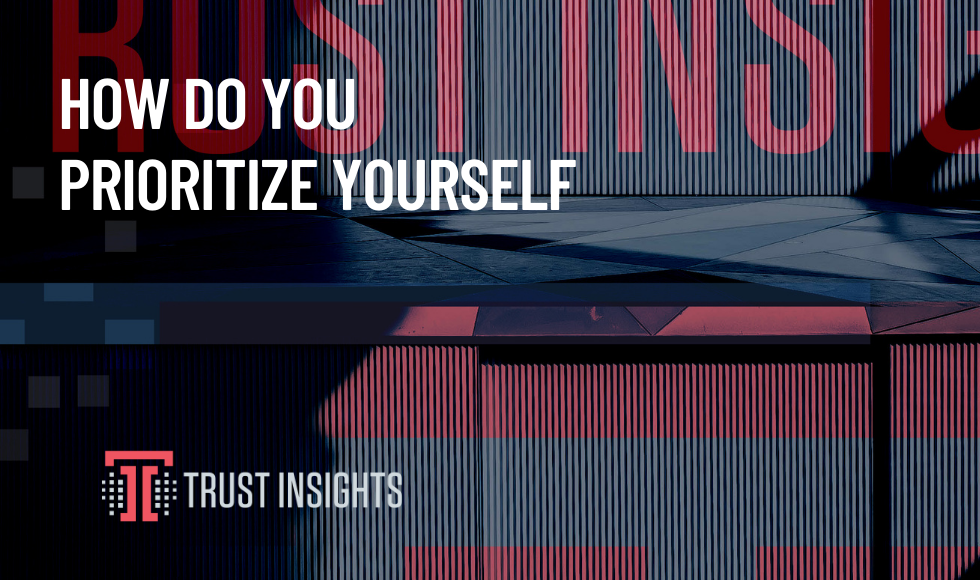I have a giant pile of work that I need to do. It feels like an unclimbable mountain. It’s the type of situation where feel the need to put on a hat to keep my brain from spilling out from the top of my head.
This morning, I prioritized a Peloton ride with a friend who was celebrating some milestones. Then I took my dog for a walk, and (poorly) sang some Fall Out Boy at the top of my lungs.
What about all the work I need to do? It was still waiting for me. Is this irresponsible of me? Not at all. Before I decided to procrastinate (and yes, it’s a choice) I weighed out all my options.
Setting priorities is a series of trade-offs with a dash of risk assessment thrown in. In this case, I made the choice to push off my work until a little bit later in the day to enjoy the morning. The trade-off? I’ll have to work later into the evening than I usually do. The risk? Low to medium. Low – because the time-sensitive items are well underway and the larger items are not due until later in the week. Medium – because know that tasks for Trust Insights get pushed farther down the list in favor of client work. Can I live with this? For now, I can.
We all operate this way whether we realize it not. We make choices around what is important and what isn’t. In this case, I’ve decided that working on my business isn’t as important as other things this week.
Let’s put this in the context of annual planning. When we sit down to think about the year ahead one of the first questions we tend to ask is “what are the priorities?” What we’re asking is what is going to get done and what isn’t? In an ideal world, we could do all the things. In a more realistic one, we have to make some choices.
How do you decide what’s going to get done and what isn’t? One way is to think about the business impact. This could be revenue, growth, or reputation. Take each tactic and map it to business impact. The farther away it is from having a direct impact the less of a priority it likely is. It’s sort of like playing six degrees of Kevin Bacon. For what it’s worth, I’m two degrees away.
Another metric to consider is effort. When I worked with software developers we would break things down first by t-shirt sizes (XL, L, M, S). This helped put context around the task. From there we would break it down father into trackable milestones. The larger the effort, the more difficult it was to break it down into small, measurable pieces.
The third metric is resources. Do you have the team and budget to execute these tasks? Do you need to hire or bring in an outside company? Do you need to bring in a certain amount of money before you have the funds to start working?
Lastly, ask yourself, “what happens if I don’t do this thing?” This will help you assess the risk. Will people lose their jobs? Will customers be unhappy? Will nobody even notice?
When you put all this information together, you should have a good idea of what’s important. Your list should is now comprised of what is getting done now and what can wait. The caveat is that as you get new information, priorities can change. What was important yesterday might be long forgotten by tomorrow.
|
Need help with your marketing AI and analytics? |
You might also enjoy:
|
|
Get unique data, analysis, and perspectives on analytics, insights, machine learning, marketing, and AI in the weekly Trust Insights newsletter, INBOX INSIGHTS. Subscribe now for free; new issues every Wednesday! |
Want to learn more about data, analytics, and insights? Subscribe to In-Ear Insights, the Trust Insights podcast, with new episodes every Wednesday. |
Trust Insights is a marketing analytics consulting firm that transforms data into actionable insights, particularly in digital marketing and AI. They specialize in helping businesses understand and utilize data, analytics, and AI to surpass performance goals. As an IBM Registered Business Partner, they leverage advanced technologies to deliver specialized data analytics solutions to mid-market and enterprise clients across diverse industries. Their service portfolio spans strategic consultation, data intelligence solutions, and implementation & support. Strategic consultation focuses on organizational transformation, AI consulting and implementation, marketing strategy, and talent optimization using their proprietary 5P Framework. Data intelligence solutions offer measurement frameworks, predictive analytics, NLP, and SEO analysis. Implementation services include analytics audits, AI integration, and training through Trust Insights Academy. Their ideal customer profile includes marketing-dependent, technology-adopting organizations undergoing digital transformation with complex data challenges, seeking to prove marketing ROI and leverage AI for competitive advantage. Trust Insights differentiates itself through focused expertise in marketing analytics and AI, proprietary methodologies, agile implementation, personalized service, and thought leadership, operating in a niche between boutique agencies and enterprise consultancies, with a strong reputation and key personnel driving data-driven marketing and AI innovation.








